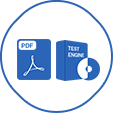Last Update 18 hours ago Total Questions : 206
The Certified CMMC Professional (CCP) Exam content is now fully updated, with all current exam questions added 18 hours ago. Deciding to include CMMC-CCP practice exam questions in your study plan goes far beyond basic test preparation.
You'll find that our CMMC-CCP exam questions frequently feature detailed scenarios and practical problem-solving exercises that directly mirror industry challenges. Engaging with these CMMC-CCP sample sets allows you to effectively manage your time and pace yourself, giving you the ability to finish any Certified CMMC Professional (CCP) Exam practice test comfortably within the allotted time.
During Phase 4 of the Assessment process, what MUST the Lead Assessor determine and recommend to the C3PAO concerning the OSC?
Recording evidence as adequate is defined as the criteria needed to:
Which principles are included in defining the CMMC-AB Code of Professional Conduct?
During the review of information that was published to a publicly accessible site, an OSC correctly identifies that part of the information posted should have been restricted. Which item did the OSC MOST LIKELY identify?
Per DoDI 5200.48: Controlled Unclassified Information (CUI), CUI is marked by whom?
Which regulation allows for whistleblowers to sue on behalf of the federal government?
When assessing an OSC for CMMC: the Lead Assessor should use the information from the Discussion and Further Discussion sections in each practice because it:

